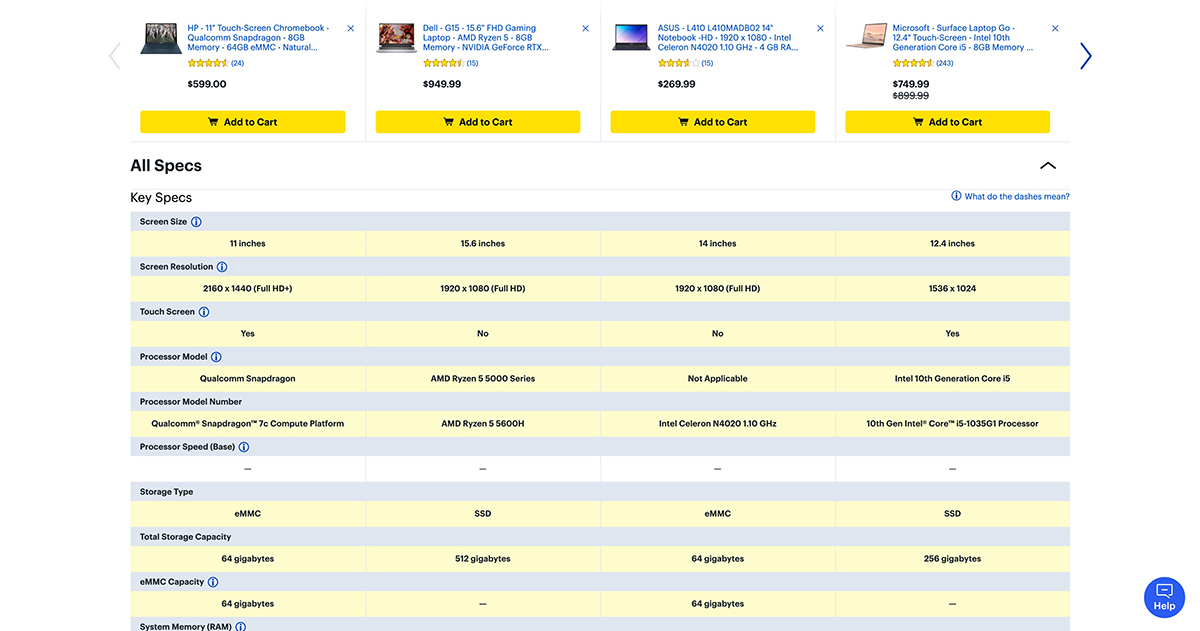
January 6, 2022
If you’ve shopped around for a computer or smartphone, you may have seen the specification cards next to each device. These cards list details about a device’s build to help you choose between multiple options. If you’re shopping online, you may see that same information displayed like this:
Some of the information on these spec cards may be important to consider when buying a new device, such as storage capacity, processing speed, system memory, operating system, screen size, screen resolution, battery life, and so on, but it can be difficult to understand what these things mean and why they can be important when upgrading your device or shopping for a new one. The purpose of our What Is…? Tech Series (in blog and video form) is to demystify what these things (storage capacity, processing speed, system memory, etc.) mean and how they work. For instance, you may notice you don’t see CPU anywhere on that spec card, but it’s there.
The CPU, or central processing unit, goes by many names, such as processor, central processor, or microprocessor. A computer's CPU handles all instructions it receives from hardware and software running on the computer.
As you research what kind of computer you want, you’ll see the CPU commonly described as a computer’s brain.

You may also see it described another way:
A computer is like a kitchen at a restaurant. The computer's processor is like a chef, who works to prepare the food. The faster the chef, the faster food is ready. A dual-core processor is like having a kitchen with two chefs, so two things can be prepared at the same time.
You can think of the CPU as the brain—or as a chef in a kitchen if that’s better imagery for you—but it’s more appropriate to refer to software like your operating system as the brain and the CPU as a very efficient calculator.
A CPU is really good with numbers, but if it weren't for the software, it wouldn't know how to do anything else. The CPU works with your software to take an input, process it, then produce an output.
Inputs give information to your computer: keyboards, touchscreens, microphones, cameras, scanners, sensors, and so on. These input devices convert physical input into binary information (0s and 1s) for your computer to understand. The memory (RAM) stores this information, and the CPU calculates the information. From there, output devices, like your monitors, printers, headphones, speakers, projectors, GPS, etc., receive the information, converting it from binary to a physical output.
So, let’s put this technical stuff into perspective:
When you press a key on your keyboard, your keyboard converts that letter into a number. For example, when I type the letter B, my keyboard converts that into binary digits: B is 01000010 in binary notation.
My CPU then must calculate how to display that information pixel by pixel on my laptop monitor…but it’s not great at remembering everything. It has way less built-in memory, or cache, than my RAM or hard drive. The cache asks the RAM for the instructions on how to display the letter B, acquiring that information and predicting any additional information the CPU may need. The CPU can now run the calculations for how to draw this character and stores that information back in the cache in case it needs it again later. Finally, this information is sent to the output device, my monitor, which converts the binary information into what you see on the display. So how would this work if you wanted to open a program like your email app or an internet browser? Find out in What Is a CPU? Part Two!
In the meantime, check out my What Is…? Tech Series: CPU video on YouTube to learn more!
You can also revisit other blogs in my What Is…? Tech Series here and search for CPU in MCPL’s LinkedIn Learning for Library online resource.
Brityni S.
Consumer Tech Specialist
Read Similar Blogs:
Technology












